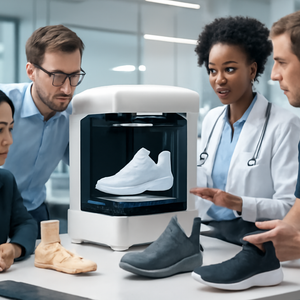
Step Into the Future: 20 Careers Shaping 3D-Printed Orthopedic Footwear
Picture this: You stroll into a clinic, slip off your shoes, and within an hour, walk out wearing perfectly custom-fitted insoles—designed, printed, and molded on the spot. This isn’t science fiction; it’s happening right now in forward-thinking clinics across the globe. Thanks to breakthroughs in 3D printing and digital health, the once-slow process of crafting orthopedic shoes and orthotics has become faster, smarter, and vastly more personal. Industry stats speak volumes: By 2028, the global 3D-printed medical devices market is expected to top $6.5 billion, with custom footwear and orthotics leading the way (MarketsandMarkets, 2023). Already, about 30% of orthopedic clinics offer 3D-printed options—a number rising every year. But here’s what doesn’t make the headlines: This revolution is powered by people. Designers, engineers, clinicians, and innovators—real folks who blend technology, creativity, and compassion to change lives, one step at a time.
Job Summaries:
How to Begin Your Journey:
- Most roles require a degree in engineering, biomechanics, design, or allied health.
- Certifications such as Certified Pedorthist (C.Ped) or Additive Manufacturing Certification (AM-C) are valuable.
- Hands-on experience through internships is important.
- Key skills include CAD proficiency, 3D scanning, and digital workflow tools.
- Networking is recommended.
- Leveraging job boards is also recommended.
Orthopedic Footwear Designer:
- Designs custom shoes using 3D scans and CAD modeling.
- Daily tasks include meeting patients, modeling shoes, and overseeing digital shaping.
- Requires a degree in design or biomechanics and CAD expertise.
- Salary: $60,000–$90,000.
- Real-world example: HP FitStation designers can turn scans into shoes in less than a day.
3D Foot Scan Technician:
- Captures and processes 3D foot scans and gait data.
- Operates scanning systems.
- Ensures data accuracy.
- Requires a technical diploma or in-house training.
- Salary: $45,000–$60,000.
- Many technicians move into CAD or clinical roles.
Additive Manufacturing Specialist:
- Runs and maintains 3D printers for insoles and orthotics.
- Selects materials for 3D printing.
- Troubleshoots 3D printing machines.
- Requires engineering or manufacturing background.
- Salary range: $55,000–$85,000.
- Industry leaders like Nike use in-house 3D printing to cut prototype times.
Podiatrist (with Digital Focus):
- Uses 3D scanning and modeling for diagnosis and treatment.
- Analyzes scans and prescribes orthotics.
- Collaborates with designers.
- Requires a medical degree and digital health training.
- Salary: $110,000–$175,000.
- Clinics using 3D-printed orthotics see reduced patient discomfort.
Orthotic & Prosthetic CAD Designer:
- Converts foot scans into orthotic device designs.
- Creates parametric models.
- Preps files for production.
- Requires a biomedical engineering degree.
- Requires advanced CAD skills.
- Salary: $65,000–$95,000.
Footwear 3D Printing Machine Operator:
- Maintains and calibrates 3D printers.
- Post-processes products.
- Troubleshoots errors.
- Requires technical certification or experience.
- Salary: $45,000–$65,000.
- Entry-level path into additive manufacturing.
Biomechanical Gait Analyst:
- Studies patient movement to inform design
- Captures motion data
- Recommends design tweaks
- Requires a degree in biomechanics or related field
- Salary: $60,000–$85,000
- Dynamic gait analysis can boost orthotic effectiveness
Orthopedic Shoe Fitter:
- Ensures custom shoes fit perfectly.
- Adjusts orthopedic devices as needed.
- Educates patients about proper shoe use and device care.
- Requires shoemaking or pedorthics training.
- Salary range: $45,000–$65,000.
- Certification as a pedorthist is highly beneficial.
3D Orthotics Product Developer:
- Takes products from concept to clinic.
- Coordinates teams involved in product development.
- Refines product designs for optimal performance.
- Oversees product testing to ensure quality and safety.
- Requires a degree in product design, engineering, or biomedical science.
- Salary range is $70,000–$110,000.
- Example company: SOLS Systems, known for rapid growth with custom insoles.
Clinical Application Specialist:
- Helps clinics implement and troubleshoot 3D tech.
- Trains staff on 3D technology usage.
- Ensures compliance with relevant standards and protocols.
- Requires a clinical background.
- Requires technical skills.
- Salary range is $65,000–$100,000.
Digital Workflow Coordinator:
- Manages patient data and production workflow
- Coordinates teams
- Tracks orders
- Requires project management or health tech experience
- Salary: $55,000–$80,000
Research Scientist (3D Printed Orthopedics):
- Leads research on new materials and methods.
- Conducts trials and publishes findings.
- Requires a PhD or Master’s in a relevant field.
- Salary: $75,000–$130,000.
- Studies show 3D-printed insoles can improve gait for children with cerebral palsy.
Custom Insole Designer:
- Designs insoles tailored to foot anatomy using scan data and modeling tools.
- Collaborates with podiatrists.
- Oversees prototyping.
- Requires a degree in industrial design or biomechanics.
- Requires CAD expertise.
- Salary: $55,000–$85,000.
Patient Care Coordinator (Custom Orthotics):
- Guides patients through the process.
- Schedules procedures.
- Ensures patient satisfaction.
- Requires healthcare administration or customer service background.
- Salary range: $45,000–$70,000.
Quality Assurance Specialist:
- Ensures products meet standards.
- Develops tests.
- Handles compliance.
- Requires QA, engineering, or orthopedics background.
- Salary: $55,000–$85,000.
Orthopedic Footwear Marketing Specialist:
- Promotes 3D-printed solutions.
- Creates marketing campaigns.
- Gathers customer feedback.
- Organizes outreach activities.
- Requires a degree in marketing or health sciences.
- Salary range: $50,000–$90,000.
- Digital marketing skills are in demand.
3D Printing Software Engineer:
- Builds and improves scan, modeling, and printing applications.
- Automates workflows.
- Integrates AI tools.
- Requires a computer science or software engineering degree.
- Salary: $80,000–$130,000.
Materials Scientist (Footwear):
- Develops new materials for footwear.
- Tests polymers.
- Collaborates with teams.
- Requires an advanced degree in materials science or engineering.
- Salary: $75,000–$120,000.
Orthopedic Shoe Pattern Maker (Digital/3D):
- Translates designs into digital templates.
- Merges traditional and digital methods.
- Checks fit of orthopedic shoe patterns.
- Requires shoemaking, CAD, or digital fabrication training.
- Salary range: $50,000–$80,000.
Regulatory Affairs Specialist:
- Handles compliance and approval processes for medical footwear.
- Prepares documents.
- Liaises with regulators.
- Requires regulatory affairs or med tech experience.
- Salary: $65,000–$110,000.
Fast Facts & Fun Notes:
- Some clinics can now scan and print insoles while you wait.
- Readers are encouraged to reflect on which career suits their strengths—problem-solver, designer, educator, or tech wizard.
Resources & Next Steps:
- Lists professional groups (AOPA, AMUG), certifications, courses, job boards, and events for networking and professional development.
Every step you take in this field is a step toward helping people move better and live fuller lives. Whether it’s designing the next breakthrough in comfort, developing smarter materials, or guiding a patient through their first scan, the future of orthopedic footwear is wide open—and you can help shape it.
Explore More Jobs

